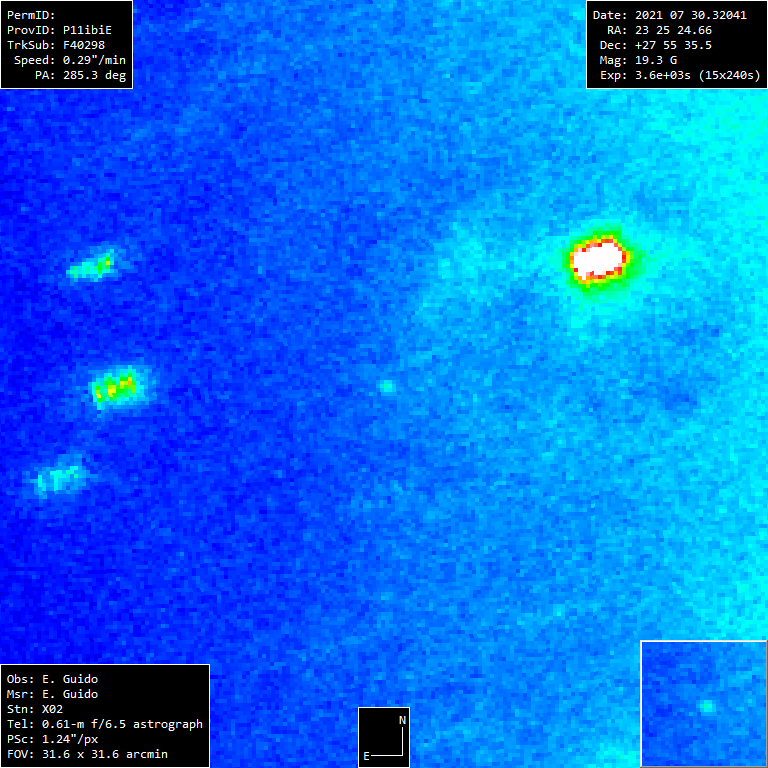
Comet C/2021 O3 discovery
A new comet discovered in late July 2021 ago is now approaching the inner solar system. It might reach at least binocular visibility by late April and early May 2022. The IAU Minor Planet Center in Cambridge, Massachusetts designated it as Comet C/2021 O3 (PanSTARRS) on August 1. Confirmation images show a compact coma or cometary atmosphere (see image above). Interestingly, the comet’s orbit appears to be parabolic. That is, the orbit’s shape indicates this comet has just enough escape velocity to pull away from our sun’s gravity. It’s due to sweep past our sun. And, if it survives that sweep, it’ll then head outward. Unless perturbed by a larger body (such as Jupiter), it stands a chance of veering into the wider space of our Milky Way galaxy, never to return.
Scientists first observed C/2021 O3 (PanSTARRS) on July 26. They were using the 71-inch (1.8-meter) Pan-STARRS 1 telescope in Hawaii. They found it in the direction of our constellation Pegasus the Flying Horse (see the Facebook post below). And they found it when it was still 4.3 astronomical units (AU) from the sun (more than four times Earth’s distance). It’s still exceedingly dim as seen from Earth at magnitude 20. Observations allowed scientists to calculate its orbit, which shows it will be at perihelion (closest to the sun) around April 20-21, 2022. The comet’s closest distance to Earth will follow this event. It’ll be closest to us around May 7-9, 2022.
Will it be visible to the eye?
Possibly, though it appears the celestial visitor might be better as a binocular object. Comets are unpredictable. And it’s too early to know what to expect from this new comet. One thing we do know is that the comet will be close to the sun when brightest. So observers will need an unobstructed view to the northwest horizon to glimpse it some months from now, shortly after sunset.
The best opportunities to try observing Comet C/2021 O3 (PanSTARRS) will be in late April 2022 and slightly improving by early May 2022.
Calculations indicate it might reach magnitude 7 or 6, and perhaps even 5.5 (lower numbers are brighter). Don’t get too excited if you see some claims of “bright comet is coming.” Comets are very erratic and unpredictable, and most require optical aid.
Be aware that another comet, C/2021 A1 (Leonard) might provide very nice views by December 2021. Keep watching the sky!
Charts for April and May, 2022
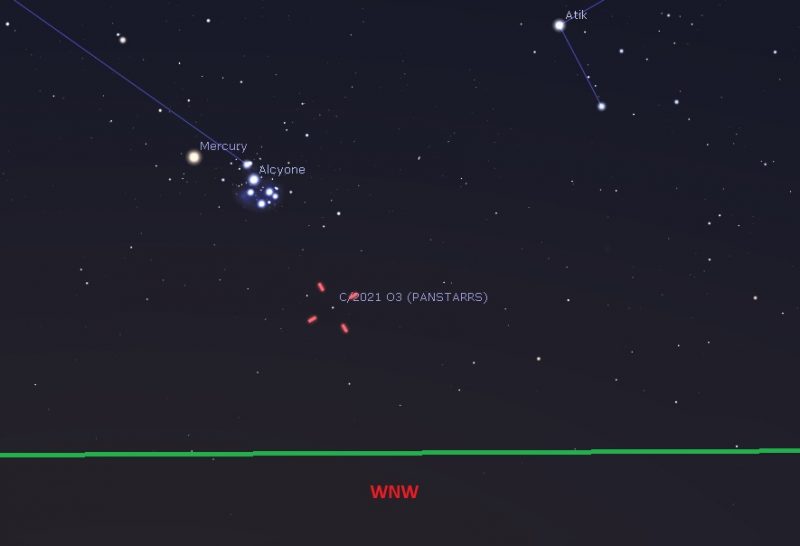
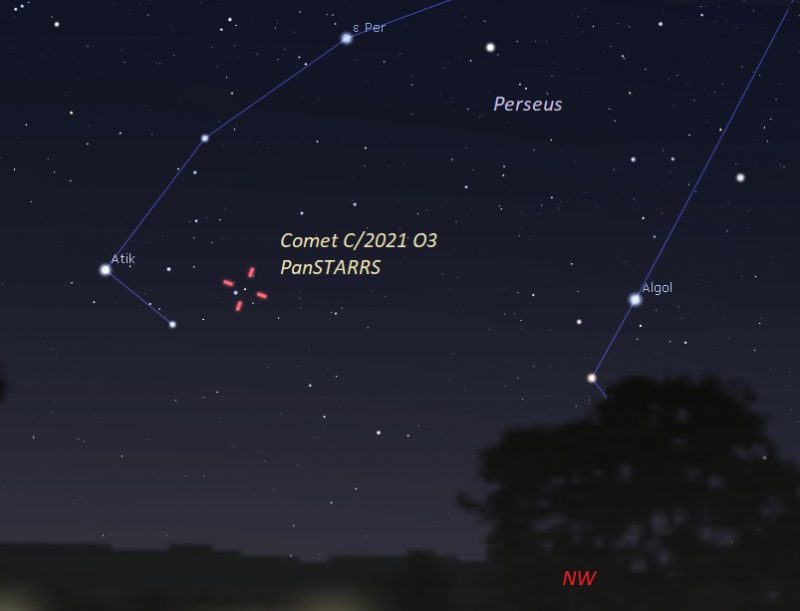
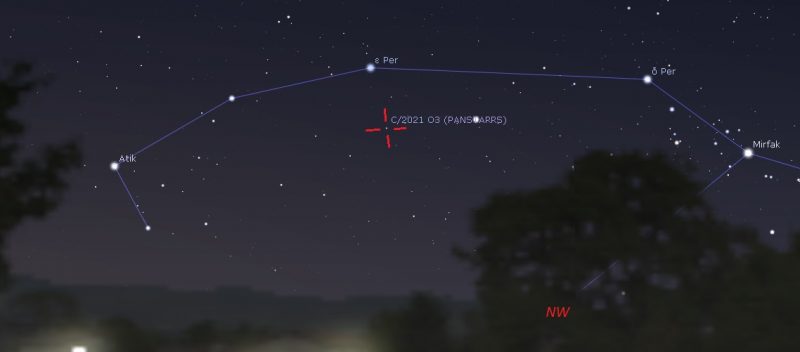
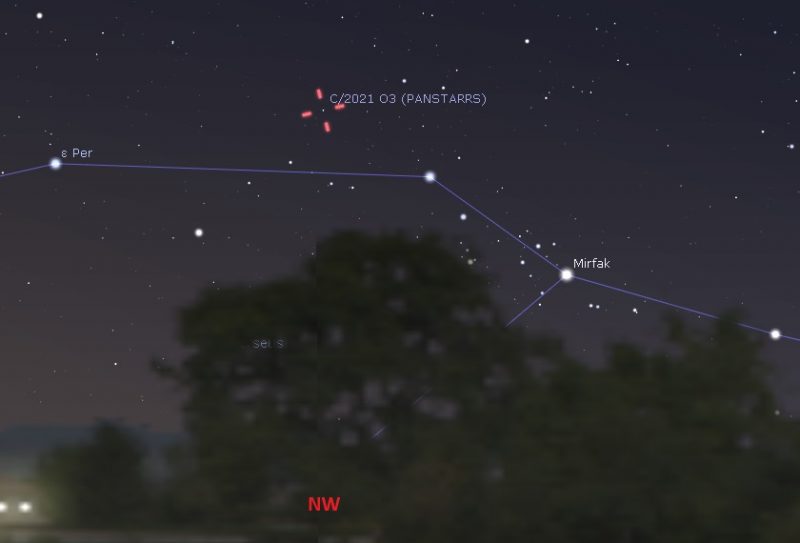
Bottom line: A new comet named C/2021 O3 PanSTARRS will visit the sun and be closest to Earth in the spring of 2022. It might become visible to the unaided eye.
The post Comet C/2021 O3 approaching, may brighten in 2022 first appeared on EarthSky.
from EarthSky https://ift.tt/3rT1qyS

Comet C/2021 O3 discovery
A new comet discovered in late July 2021 ago is now approaching the inner solar system. It might reach at least binocular visibility by late April and early May 2022. The IAU Minor Planet Center in Cambridge, Massachusetts designated it as Comet C/2021 O3 (PanSTARRS) on August 1. Confirmation images show a compact coma or cometary atmosphere (see image above). Interestingly, the comet’s orbit appears to be parabolic. That is, the orbit’s shape indicates this comet has just enough escape velocity to pull away from our sun’s gravity. It’s due to sweep past our sun. And, if it survives that sweep, it’ll then head outward. Unless perturbed by a larger body (such as Jupiter), it stands a chance of veering into the wider space of our Milky Way galaxy, never to return.
Scientists first observed C/2021 O3 (PanSTARRS) on July 26. They were using the 71-inch (1.8-meter) Pan-STARRS 1 telescope in Hawaii. They found it in the direction of our constellation Pegasus the Flying Horse (see the Facebook post below). And they found it when it was still 4.3 astronomical units (AU) from the sun (more than four times Earth’s distance). It’s still exceedingly dim as seen from Earth at magnitude 20. Observations allowed scientists to calculate its orbit, which shows it will be at perihelion (closest to the sun) around April 20-21, 2022. The comet’s closest distance to Earth will follow this event. It’ll be closest to us around May 7-9, 2022.
Will it be visible to the eye?
Possibly, though it appears the celestial visitor might be better as a binocular object. Comets are unpredictable. And it’s too early to know what to expect from this new comet. One thing we do know is that the comet will be close to the sun when brightest. So observers will need an unobstructed view to the northwest horizon to glimpse it some months from now, shortly after sunset.
The best opportunities to try observing Comet C/2021 O3 (PanSTARRS) will be in late April 2022 and slightly improving by early May 2022.
Calculations indicate it might reach magnitude 7 or 6, and perhaps even 5.5 (lower numbers are brighter). Don’t get too excited if you see some claims of “bright comet is coming.” Comets are very erratic and unpredictable, and most require optical aid.
Be aware that another comet, C/2021 A1 (Leonard) might provide very nice views by December 2021. Keep watching the sky!
Charts for April and May, 2022




Bottom line: A new comet named C/2021 O3 PanSTARRS will visit the sun and be closest to Earth in the spring of 2022. It might become visible to the unaided eye.
The post Comet C/2021 O3 approaching, may brighten in 2022 first appeared on EarthSky.
from EarthSky https://ift.tt/3rT1qyS

Aucun commentaire:
Enregistrer un commentaire